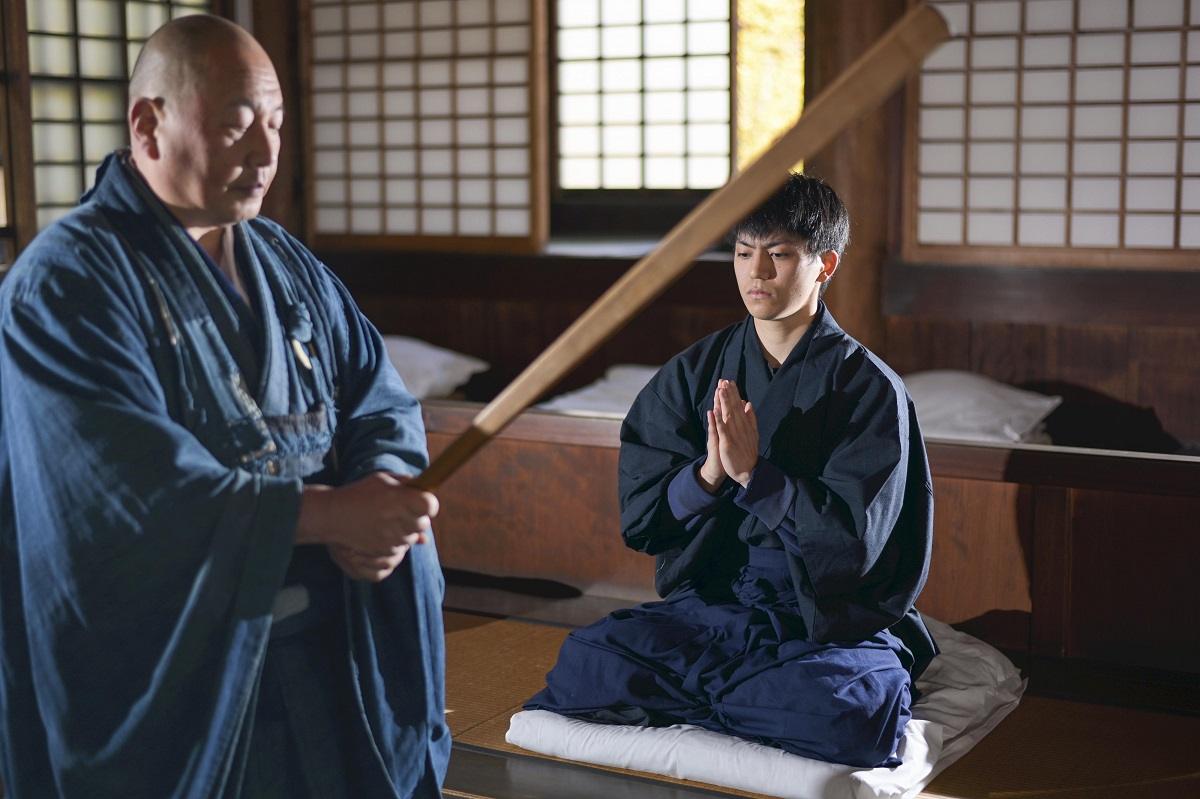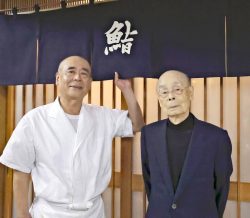
Naoto Hosohara, right, practices zazen seated meditation at Nagaoka Zen Juku Zen Buddhism training hall in Nagaokakyo, Kyoto Prefecture. At his left is Zen Buddhist monk Genso Hasegawa.
18:04 JST, July 1, 2023
NAGAOKAKYO, Kyoto — A training hall for Zen Buddhism in Nagaokakyo, Kyoto Prefecture, which accepts live-in university students rent-free, is in dire straits, as the number of students has fallen drastically.
Nagaoka Zen Juku is one of the few dojo training halls for Zen Buddhism in the country and dates back more than 80 years. Young people today are apparently put off by the hall’s strict daily routines, such as zazen sitting meditation.
Currently, only one student lives in Nagaoka Zen Juku, which is struggling to figure out how to preserve its traditions.
The hall was founded in 1939 to train human resources through Zen Buddhism. It’s run by a public interest incorporated foundation and sponsored by about 10 companies, including general trading house Sojitz Corp. and Kansai Paint Co.
Some companies use the facility to train their own employees.
The premises cover 5,000 tsubo or roughly 16,000 square meters. Students are required to practice zazen and clean the facility in the morning and the evening under the instruction of the roshi master. Each student is given free room and board.
There is no fixed length of time for training at the hall, and those who have completed their training can choose whatever career path they want to take afterward.
During the Showa era (1926-89), all 20 of the dorm rooms for students were continually full, with many people waiting for vacancies. In recent years, the number of students decreased to just several at a time, partly due to Japan’s declining birth rate.
Then came the novel coronavirus pandemic, which dealt a severe blow to the Nagaoka Zen Juku. There were no students around 2021, when most universities held classes remotely.
“I presume people shied away from living with others in the dormitory because they were afraid of infection,” said Daiun Kitano, 80, the roshi master and the fourth head of Nagaoka Zen Juku.
To raise public interest, Nagaoka Zen Juku introduced a two-week trial course.
Overcoming weaknesses
Kyoto University senior Naoto Hosohara, 25, entered Nagaoka Zen Juku in October last year. Although two students from other universities joined him in April, they quit after about a month. As of June, Hosohara is the only live-in student.
Hosohara gets up before 5 a.m. and practices zazen meditation for an hour. He sweeps the garden and does other chores until 8:30 a.m. During the day, he attends university classes or works part-time, then he practices zazen for another hour in the evening.
“At first, it was hard. But I’ve overcome my weaknesses one by one. I feel like I’m making progress every day,” Hosohara said.
More than 300 people have trained and lived in Nagaoka Zen Juku. The alumni include doctors, university professors and a head priest of a Buddhist temple in Kyoto. Political scientist Takehiro Otsuka, 65, a former dean of Himeji Dokkyo University, stayed at Nagaoka Zen Juku for two years while he was a postgraduate student of Kyoto University.
“The patience I acquired at this dojo made me strong enough not to run away from anything in my later life,“ Otsuka said.
Monks decreasing as well
The number of monks aspiring to become Zen Buddhist priests is also declining. Normally, such people become an apprentice at a temple and train under its head priest and others before being ordained as a monk.
The monk will then spend more than six months training and living at a special training hall for priests. Only then can they qualify as a candidate to be a head priest of a temple.
Becoming a Zen Buddhist priest is said to be tougher than becoming a priest at the temples of most other Buddhist sects because monks of the other sects do not need to train at a special training hall.
There are three Zen Buddhism sects in Japan. The combined number of monks of two of them dropped below 200 last year, losing about 100 over the past six years. Eight of the 41 Zen Buddhist priest training halls no longer have any monks.
The third sect, Soto Zen Buddhism, used to have 26 priest training halls across the country that were authorized by the sect. However, their number had shrunk to 17 as of October last year.
In contrast, workshops for members of the general public, in which they can experience zazen meditation, are popular among middle-aged and elderly people. At Myoshinji Temple in Ukyo Ward, Kyoto, the 20 available places at a monthly zazen workshop session are filled immediately after booking opens. Many of the participants are men in their 50s to 70s, according to the temple.
“Young people today are busy following the vast amount of information they get on smartphones, so they have little time to face themselves or think about life. Maybe they’re not compatible with Zen Buddhism,” said Yohei Harada, a professor of the Shibaura Institute of Technology who is well-versed in youth culture.
Related Tags
"Features" POPULAR ARTICLE
-

Sanrio to Open Museum in Yamanashi Pref. Dedicated to Founder, Exhibits Include Hello Kitty, Other Characters
-

Legendary Sushi Chef Jiro Ono Turns 100: ‘I Have No Regrets’
-

Autumn Foliage Surrounds Visitors to Tokyo’s Showa Kinen Park
-

My Daughter No Longer Speaks to Me, But I Want to See Her and My Grandchild
-

Kumamoto: Public Bath Refurbished as Library Where You Can Chat, Take Photos
JN ACCESS RANKING
-

Keidanren Chairman Yoshinobu Tsutsui Visits Kashiwazaki-Kariwa Nuclear Power Plant; Inspects New Emergency Safety System
-

Imports of Rare Earths from China Facing Delays, May Be Caused by Deterioration of Japan-China Relations
-

University of Tokyo Professor Discusses Japanese Economic Security in Interview Ahead of Forum
-

Japan Pulls out of Vietnam Nuclear Project, Complicating Hanoi’s Power Plans
-

Govt Aims to Expand NISA Program Lineup, Abolish Age Restriction

























